Penang Itinerary: From Amazing Street Art to Unforgettable Street Food
Penang is the perfect place in Southeast Asia to get your culture and foodie fix. It’s probably one of the most culturally rich and diverse destinations in the region. You can find Malay, Chinese, Indian, and colonial British influences in its food, architecture, and religion. In 2008, the main city in Penang, George Town, was awarded UNESCO World Heritage status for its “living multicultural heritage communities and architectural treasures” (George Town World Heritage). But with all this heritage and culture, it can be a bit overwhelming trying to put together a Penang itinerary of 3 days. So, in this post, I’m going to show you EXACTLY how to spend 3 days exploring Penang.
This Penang itinerary is part of my Malaysia Itinerary. Click here to see the full itinerary on Malaysia.
Disclosure: This post may contain affiliate links. As an Amazon Associate and a Bookshop.org Associate, I earn from qualifying purchases. Please see this website's Disclosure for more info.
PENANG VS. GEORGE TOWN
Before starting the itinerary, let’s clear up the difference between Penang, George Town, and Butterworth.
- Penang is the name of both the island and the province. The province consists of the island and the mainland that sits across from it.
- Butterworth is the main town on the mainland across from Penang island. It’s NOT necessary to stop in Butterworth.
- George Town is the largest city on Penang island and in Penang province. Make this fascinating heritage city your base and spend most of your time here!
As I mentioned earlier, George Town is a UNESCO World Heritage Site. The Heritage Site is divided into two parts: the Core Area and the Buffer Area. The Core Area has most of the important historical and cultural sites and the best pre-war architecture. The Buffer Area has some heritage sites as well, such as the Blue Mansion and the Eastern and Oriental Hotel. Take a look at this map to learn where the two zones are.
History of Penang
Penang was originally ruled by the Sultan of Kedah. However, in the late 1700s, the Thais began giving him some trouble, so the Sultan went looking for an ally. He found it in the British, or so he thought.
In 1786 the Sultan gave Penang to the British East India Company in exchange for protection from the Thais and 30,000 Spanish dollars a year. From that point on until 1957 (except from1942-1945 when the Japanese occupied Malaysia), Penang was under British control.
Unfortunately, the Sultan got a raw deal. The British never completely lived up to their end of the bargain. The Sultan did get the money, but the British never came to his aid when the Thais gave him trouble again.
Under the British, Penang became a free port, attracting people from all over Asia, especially Chinese immigrants. Penang was also used as a Penal colony, and Indians were brought over by the British as convict labor. In 1867, the British Crown Colony took over the British East India Company’s administration of Penang. You can see British influence on Penang in the buildings near Swettenham Pier.
During World War II, the British decided not to defend Penang and abandoned the island, secretly evacuating many of Penang’s European residents. Japan occupied the British settlement on December 19, renaming it Tojo-to after their Emperor.
The Japanese occupation was a terrible time for the Chinese population in Penang. Thousands of Chinese were murdered. Like the comfort women in Korea, Chinese women were also forced to serve the Japanese army as prostitutes. I highly recommend reading Tan Wan Eng’s beautifully-written novel on Penang that was set during WWII, The Gift of Rain.
Today, Penang has one of the strongest economies in Malaysia. Its unemployment rate and level of inequality are the lowest in the country. And it has become the center of Malaysia’s high tech industry.
Penang is 40% Chinese and 10% Indian. The high density of Chinese has given them control over Penang’s state government since Malaysian independence. This is significant since there are few places in Malaysia where Malays do not control the local government. To learn more about how the Malaysian government handles the multi-ethnic makeup of the country, read Crossroads: A Popular History of Malaysia and Singapore.
If you want more info on Malaysia, you can check out my list of Best and Worst Books on Malaysia.
HOW TO GET TO PENANG
Getting to Penang is a bit tricky because bus companies list two destinations: Butterworth and Penang (island). I’ll explain the differences below.
For the most up-to-date information on transportation around Penang, visit the Penang Global Tourism Website.
By Bus
Getting to Penang by bus can be a bit confusing at first because if you search for bus tickets online like at 12Go.Asia, you’ll get 2 destinations: Butterworth and Terminal Bus Sungai Nibong, Penang. Which one should you choose?
- Butterworth is the terminal on the mainland. If you choose that as your destination, you’ll still need to take a ferry across the strait to Penang. So, DON’T select it.
- Terminal Bus Sungai Nibong, Penang is the bus terminal on the island of Penang and more specifically on the outskirts of George Town (don’t expect to just walk to your hotel). If this is your destination, you’ll just need to take a taxi or Grab into George Town. Choose THIS one
I bought a ticket for Terminal Bus Sungai Nibong. And then I took a Grab (similar to Uber but you pay cash at the end of your ride) from the terminal to my hotel. You can read all about how to get from Melaka to Penang by bus in my Malaysia Itinerary post.
By Train
You can take a train from various points in Malaysia to Butterworth Station. It seemed a real hassle going by train, so I never did it in Malaysia.
- Kuala Lumpur Sentral – 4.5 hours
- Ipoh – 1 hour 40 minutes
- Johor Bahru (on the border of Singapore) – you need to transfer at Gemas
By Air
You can also fly into Penang daily from any major airport in Malaysia and the region. Check out 12Go.Asia for airfares. I haven’t taken a plane in Malaysia, but prices look good on their website. Almost too good to be true.
According to the Penang Global Tourism website, to get from the airport to different locations around Penang by taxi, there’s a coupon system with fixed prices.
By Boat
You can get to Penang by boat from Langkawi Island. You can buy your tickets online at 12Go.Asia or buy them at the port in Langkawi. Just show your phone with the ticket upon boarding. You can get more info. on this route in my Malaysia itinerary post.
For detailed info on getting to Penang from Kuala Lumpur, check out this post on Getting to Penang from Kuala Lumpur.
HOW TO GET AROUND PENANG
You have several options for getting around Penang from the cheapest (foot) to the most expensive (Grab or taxi).
By Foot
George Town is really compact, so you can easily get around by foot. If you’re staying outside the heritage area, you can take a Grab (similar to Uber but you pay in cash at the end of your ride).
By Bus
For other parts of the island, you can take the public bus system called Rapid Penang. The best place to catch the bus is at the KOMTAR terminal. When you get on the bus, tell the driver where you want to go and pay the required amount. This can be tricky. When I took the bus, I told the driver the wrong stop (thanks Google Maps). While on the bus, I figured out my error and got off at the correct stop, which was one stop after the one I told the driver. Since fares are based on distance traveled (my correct stop was more expensive than the one I told the driver), the driver was not too happy with me.
Free CAT (Central Air Transit) Bus
This free bus route services the heritage area of George Town. I never used it because George Town is really compact and Grab is inexpensive. If you want more information on it, ask at your hostel or hotel or at the Penang Tourist Information Center.
WHERE TO STAY IN GEORGE TOWN
I’m a history and architecture nerd, so whenever I get a chance to stay in a historic building with lots of character, I’m gonna do it. Penang has lots of hotels like this called heritage hotels. They are old shophouses converted into hostels, guesthouses, and hotels. You can find something in any price range. The best area to find heritage hotels is in the World Heritage Zone. Take a look at this map to find out where the Zone is.
Heritage hotels share certain design features. They are usually two stories and long and narrow with a central courtyard in the middle separating the front and back sections. In the past, the front part was the owner’s shop and the back and second floor their home. Today, the front end is the lobby and the back the dining area. The guest rooms are on the second floor. You’ll often find exposed brick or plaster walls with paint peeling to purposely give the hotel that aged look. You’ll find a combination of traditional eastern and modern furniture.
You can learn more about the history of these buildings in my Melaka Itinerary post.
For budget accommodations, expect to pay around US$6 to $10, for mid-range $35 to $60, and for top-end over $100.
Where I stayed – A gorgeous mid-range heritage hotel
I stayed at Carnarvon House (AGODA / BOOKING.COM) in the Core Area of the World Heritage Zone. It’s an elegantly designed mid-range heritage hotel located near Armenia Street. The owner was friendly and knowledgeable. Breakfast was interesting. They would get your breakfast from different restaurants around the city. Each day was a bit different. You can have western or local food. The downside is that the bathrooms are shared, and the rooms are quite small and simple.
Other accommodation options for your 3 days in Penang
If the price or shared bath don’t work for you, try these other popular accommodations:
- The Frame Guesthouse – (AGODA / BOOKING.COM) – This hostel is in the heart of the heritage zone but since it’s not on Love Lane, it’s quieter. There are dorm rooms and private rooms.
- Betel Nut Lodge – (AGODA / BOOKING.COM) – Betel Nut Lodge is a mid-range priced hotel in the core area of the UNESCO Heritage Zone.
- Cheong Fatt Tze – The Blue Mansion (4-star hotel) – AGODA / BOOKING.COM – If money were no object for me, I’d stay at the historic Blue Mansion–an elegant hotel with lots of character. The hostel has a fascinating history. It was once the mansion of a powerful and wealthy local Chinese man, Cheong Fatt Tze. It fell into disrepair and was like that for many years until it was bought, renovated, and turned into a 4-star hotel. You can find rooms for less than $200. You can go on a tour of the Blue Mansion (jump to Day 2 of this 3-Day Penang itinerary).
PENANG ITINERARY: DAY 1
So, here we are on day 1 of your Penang itinerary—your first FULL day in Penang. If you’re following my Malaysia itinerary post, then you’ll be arriving in the late afternoon. That means the first-day setting foot on the island is shot. You’ll just have time for dinner.
Where to eat in Penang
Here’s what I did: My plan the first night was to eat at the Chulia Night Market close to my hotel, so I set out on foot (got rained on and had to wait out the rain under a shophouse awning) and came upon a restaurant with a line of people waiting outside of it.
The first rule of thumb of travel: eat at a place that’s popular with locals.
So, I joined the line of locals (and some tourists) to eat at what turned out to be (per a local who I shared a table with) one of the most popular Chinese restaurants in Penang: Tek Sen. Since I was a solo traveler, I didn’t have to wait long. They just put me at a table with other customers. Malaysians are so friendly that my table mates made me feel welcome and I didn’t feel awkward eating alone.
Tak Sen a bit pricier than going to night markets in Penang (RM44). I ordered two dishes: the popular Twice Cooked Pork with Chili Padi sauce and Duck with Ginger. The first dish was sweet and tasty, but the latter dish bland and uninspiring. I had originally wanted duck with yams (my top 10 favorite dishes in the world), but they were out. For solo travelers who love food, order 2 dishes. They’re not large portions.
So, let’s get back to your first official FULL DAY in Penang:
1. Walking tour of Penang
COST: free | TIME: 10:30-12:00 pm | ADDRESS: 10, Ground Floor, The Whiteaways Arcade, Lebuh Pantai (Beach Road), 10300 Penang
The best thing I did in Penang was to join the free Walkabout Tour through the Penang Tourist Information Center.
Tours take place on Tuesdays, Thursdays, and Saturdays starting at 10:30 am and ending at 12:00 pm. Sign up before 10:00 at the Penang Tourist Information Center (see Google maps). Tours are limited to 20 people. When I did the tour, they were turning away people, so sign up early!
The tour begins at the Tourist Information Center and takes you around the streets of the Colonial District of George Town ending at the Chaozhou Clan Temple (Han Jiang Ancestral Temple) near Little India. You’ll pass by the old banks from colonial times, Fort Cornwallis, the Padan (the large open field where the British played cricket), the former British Officer’s Club, City Hall, and the House of Yeap Chor Ee. The tour will take you down the Streets of Harmony where you’ll hear stories about St. George’s Church, Goddess of Mercy Temple, and the Kapitan Keling Mosque.
The guide told us lots of interesting stories about the history of Penang, the characters who lived and visited the city, and the story of the buildings and architecture. We didn’t go inside any buildings. Although the tour is free, you should still tip.
The Penang Tourist Information Center opens at 9:00 am. They provide lots of great maps and brochures. Pick up the street art map! There’s a restroom in the same building.
2. Lunch
At the end of the tour (12:00 pm), you might be hungry like I was. Your best bet for lunchtime restaurants is in Little India, near the last stop on your tour.
- At the end of the tour, the guide pointed out an Indian place nearby for lunch, and I joined another solo traveler from the tour for lunch. Unfortunately, I didn’t write down the name of the place.
3. Pinang Peranakan House Museum
COST: RM20 | OPEN: M-Su 9:30 am – 5:00 pm | ADDRESS: 29 Church St. George Town 10200 George Town, Penang
Penang is HOT! Blazing hot. I tried to stay out of the sun in the afternoon. So, I suggest heading over somewhere inside like the Pinang Peranakan Mansion. The mansion used to be the home of a rich Peranakan Chinese merchant. Visiting it gives you a great opportunity to learn about the Peranakan culture.
Who are the Peranakans?
Peranakan (also referred to as Baba Nyonya) is a Malay word used to describe the offspring of foreign fathers and Malay mothers. Long ago when Chinese traders first settled in Malaysia and Singapore, they married local Malay women. The couple had children (Peranakans) and their children married other Peranakans or Chinese immigrants.
There are also words used to describe the offspring of Indian fathers and Malay mothers (Jawi Peranakan). But Chinese Peranakans are the largest Peranakan group.
Peranakans developed their own unique hybrid culture mixing a bit of Chinese culture and a bit of Malay culture.
Nowadays, it’s hard to distinguish between a Peranakan Chinese and non-Peranakan Chinese in Malaysia and Singapore. They’re now referred to as Straits Chinese. The Singaporean families in the book and movie Crazy Rich Asians were Straits Chinese.
The mansion shows you how the Peranakan Chinese lived in pre-war George Town. It’s opulent and gorgeous. It even includes the family’s private temple. It’s now been turned into a museum filled with the antique collection of its new owner, Peter Soon.
You can go on a guided tour and then wander around on your own. To be honest, my tour guide was annoying as heck. He spent more time talking about the current owner than about the original ones or about Peranakan culture.
The Peranakan Mansion is larger and more ornate than the ones in Melaka and Singapore (Baba House), but the tours of the latter two were much more interesting and informative. Check out my Melaka itinerary post and Singapore itinerary post on how to go on these tours.
4. Food Tour
Penang is all about the food! So, do at least one food tour so that you can efficiently sample what the island has to offer. The good news is that food tours are reasonably priced compared to places like Singapore or Japan. I really enjoyed the food tour I went on, Food Tour Penang. I would have probably loved it even more if I had had a bigger stomach at the time. So much food!
- Food Tour Penang – US$62 – As I mentioned, I went on this food tour. You can book your food tour here.
- Heritage on a Plate – US$60 – A friend went on this tour and loved it! You can book your tour here.
I’ve been on tours all over Southeast Asia (Vietnam, Myanmar, Singapore) and Japan, and I have to say that my tour with Food Tour Malaysia offered the most dishes of any tour I’d ever been on before(16 dishes!). My only complaint is that I wish the guide had been friendlier.
There were 3 of us on the tour: me and a couple from Australia with 2 guides (Kevin – driver (nice guy) and Junie – guide (rather aloof). Another good thing about the food tour was that we drove around to different parts of the city to sample the different foods, so we got to see more of Penang than if we had done a walking tour.
Here is a list of stops we made and the foods we tried:
Nontouristy Neighborhood
- chendol
- assam Laksa
The Chinese Jetty
- loh bak – deep fried bread with pork and jicama; tofu, and shrimpe
- breaded sweet potato that was deep-fried
Night Market at Maccallum Housing Estates
- soya bean drink
- bean curd with palm sugar
- Nyonya Kueh – Peranakan sweets
Hawker Center Night Market
- curry mee
- char kway teow
- duck congee
- chicken wraps
- satay
- wanton mee
- nutmeg drink
Sri Ananda Indian restaurant
- paper dosa
- roti
PENANG ITINERARY – DAY 2
You can do the second day of your Penang itinerary in three different ways:
- Morning: Explore the street art and architecture and visit Armenian Street, Khoo Kongsi and the Clan Jetties; Afternoon at 2:00 or 3:30: the Blue Mansion.
- Morning: Explore the street art and architecture of Penang and do the 11:00 tour of the Blue Mansion; Afternoon: Armenian Street, Khoo Kongsi, and Clan Jetties (works well if you’re staying near Armenian Street).
- Morning: 11:00 at Blue Mansion Afternoon: Explore street art and architecture and then visit Armenian Street, Khoo Kongsi, and the Clan Jetties.
In this itinerary, I’ll explain the sights by doing plan #1. You want to be out of the sun in the afternoon.
1. Exploring George Town’s Street Art
On day 2 of your Penang itinerary, you’ll want to get up and out the door early before the heat and tourists get to you. Schedule this day to wander around the city looking at all the fabulous street art. Penang is famous for it and its fame is well-deserved.
George Town has two kinds of street art: the steel-rod sculptures and the wall murals.
- The steel-rod sculptures are sculptures attached to the walls along the street. They display caricatures of the people of George Town. These sculptures began in 2009 as a way to market the awarding of UNESCO World Heritage status. There are 52 sculptures dotted all over the Core and Buffer Heritage zones.
- The wall murals are more popular with tourists than the steel-rod sculptures. The first person to paint them was Yugoslavian artist, Ernest Zacharavic. The wall murals are also everywhere in Penang. However, you can find the greatest concentration of street art around Lebuh Armenian Street (on both sides of Lebuh Paintai (Beach Street).
The tourism center has a map of where to find the sculptures and murals. You can also get the map of George Town street art online here.
2. The Architecture of George Town
I loved the street art, but I think my favorite part of George Town was the architecture. I adored the old shophouses in their varying states of repair.
Walk around the streets of the Heritage Zone and you’ll come across buildings that are typical of Southeast Asia. They are a mix of Chinese design with European ornamentation. Houses were built long and narrow since owners were taxed according to the frontage facing the street. The owner used the first floor as a place of business, which was usually a shop selling goods and services, while they used the back section for the employee’s living quarters or the family’s home. A courtyard separated the two sections. This open space allowed air to circulate, cooling the interior. The family lived on the second floor.
As in other Straits Settlements, the British required owners to build the second floor over a “five-foot way” or sidewalk so that people could continuously walk down the street and still stay in the shade during sunny days or dry during the daily rain showers. Other governments like Taiwan and southern China passed similar laws. Unfortunately, today many of these sidewalks are used as parking places for motorcycles or storage spaces for people’s belongings. So, instead of walking along the five-foot way, you’re dodging traffic in the street.
You’ll find these colorfully painted arches around George Town. The photo on the left (first photo) is from Jalan Kek Chuan Street in the Heritage Zone. The photo on the right (second photo) is from Muntri Street or around Muntri Street.
Pro Tip – Photographing Buildings
Photographing buildings and street art can be tricky because sometimes the façade of the buildings and murals will be in the shade. You want the sun to hit the front of the building, so when to take photos depends on what direction the sunlight is coming from. If you look at a map of Penang, you’ll see that the streets are not directly east-west or north-south. So, some buildings are facing northeast and others southwest. In the morning, it’s best to photograph the buildings facing east. At high noon, you want south-facing buildings, and in the afternoon, you want west-facing buildings. You might want to explore early in the morning, at noon and then in the late afternoon.
3. Armenian Street (Lebuh Armenian)
The narrow street of Armenian Street is famous for its street art, temples, and other cultural and historic sights. It’s named after the country of Armenia. In the 1800s, many Armenian traders lived and had their businesses on the street. Hence, the name.
Besides the street art along Armenian Street, here are some of the tourist sights you can visit:
- Sun Yat-sen Museum – For those Chinese history lovers, I’m sure you know who Sun Yat-sen is. He led the overthrow of the Qing Emperor, establishing China’s first republican government. Many overseas Chinese financially supported his revolution. This is the sight where Sun Yat-sen chaired the Penang Conference, raising over $8,000 for his revolution.
- Yap Kongsi – There are two buildings: the clan house and the Choo Chee Keong temple. They were built in 1924 and renovated in 1992. You can see them on the right side in the above photo.
- Hock Teik Cheng Sin Temple – This ornate two-story temple was the headquarters of a Kien Tek Society, a secret society from Fujian province in China, from 1850 to 1890. The society was involved in the 1967 Penang Riots when rival gangs fought for 10 days over control of their turf.
4. Khoo Kong Si Clan Complex
COST: RM10 OPEN: 9:00 am – 5:00 pm daily
Near Armenian Street is the huge clan association complex of the Khoo extended family called Khoo Kongsi. It’s well worth a visit to walk through the ornately decorated clanhouse to see its beautiful murals and to learn about the history of one family’s immigration from China. I think you get a sense here more than other clan temples of how extensive a wealthy Straits Chinese family can be.
The Khoo family emigrated from a small village near Xiamen, Fujian. The first Khoo family to be born in Penang was in 1775. From 1786 to 1800, there were 30 settlers from the Khoo clan. In 1816 there were 100. They were, and probably still are, one of the wealthiest Straits Chinese families in Southeast Asia. I recall the family’s name being mentioned in Crazy Rich Asians as being one of the wealthiest families in Southeast Asia.
The complex consists of the clanhouse Leong San Tong, administrative buildings with a meeting hall and offices, an opera stage, a temple, and 62 terrace houses and shophouses. You can only enter the clanhouse.
Before the war, this complex was like a little village. It had its own defensive system, a necessity given the rampant crime and lack of public security in colonial times. Houses were built here for any member of the Khoo family who immigrated to Penang.
What are Chinese Clan Associations?
Clan Associations are a fascinating overseas Chinese custom that you’ll find anywhere there are long traditions of Chinese immigrant communities. They are community organizations for Chinese immigrants who come from the same clan, dialect, occupation, or hometown. Clan Associations were especially important in the past when communities in Southeast Asia and the United States were filling up with poor Chinese migrant laborers.
They had several functions. They helped immigrants communicate with their families in their home village. The Association helped in times of need such as during illnesses, death, and widowhood. They also organized festivals and celebrations. Sometimes they’d offer help in starting businesses, and this is one reason why certain industries are dominated by one particular clan or home province. For example, most traditional kopitiams (coffeeshops) in Southeast Asia are run by Hainanese.
Almost every clan association has its own clan deity and they build a temple dedicated to that deity.
5. Chinese Clan Jetties
COST: free to wander
You can do the Chinese Clan Jetties before or after lunch. It’s a few blocks from Khoo Kongsi. Chinese immigrants built homes on stilts over the water and connected the homes by a wooden boardwalk. You can walk along the boardwalk to have a look at the homes and get a feel for what it must be like to live over the water and in such cramped quarters.
You can skip this stop in the itinerary if you went on the food tour with Food Tour Penang. I went back because the stop on the food tour was very quick.
There are 7 clan jetties. Each jetty is the home of a family with the same surname from Fujian province in China: the Chew, Tan, Lim, etc. The biggest one is the Chew Clan Jetty. It’s also the most touristy with many of the residents having turned their home fronts into tourist stalls selling food and souvenirs.
Other jetties are not so touristy and it’s just like walking in someone’s neighborhood. On the food tour with Food Tour Penang, you’ll visit one of the less touristy jetties and sample some traditional food there.
6. Lunch
Here are some ideas for lunch:
- Jawi House – Lebuh Armenian– This restaurant serves Jawi Peranakan food. Like the Chinese Peranakans, Jawi Peranakans are the offspring of Indian Muslim fathers and Malay mothers. The cuisine is a combination of Middle Eastern, Indian, and Malay food.
- Mews Café – 77 Jalan Muntri – Malaysian food – This popular restaurant is on your way to the next stop on this Penang itinerary, the Blue Mansion.
7. Cheong Tze Fat House: The Blue Mansion
COST: RM18 for adults and RM8.5 for children – buy tickets 15 minutes before the tour starts TOUR TIME: M-F: 11:00, 2:00, 3:30; Sa-Su: 11:00 & 2:00 WEBSITE: https://www.cheongfatttzemansion.com/discover/daily-tours/
After exploring the street art, the next stop on your Penang itinerary is the Blue Mansion. Yes, it is blue. I mean really blue. A deep rich blue. It’s gorgeous.
The Blue Mansion was the original house of a rich Chinese merchant, Cheong Tze Fat. He married eight times. When he died, he bequeathed his house to his favorite wife, wife #7. In his will, he stipulated that the house could not be sold until the last son of wife #7 died (she had many sons). But he didn’t provide her with enough money for the upkeep of the house. So, the mansion fell into disrepair. Rooms were rented out to poor tenants. In 1989 when the last son died, 34 illegal squatters were living in the once elegant mansion. The current owners bought the house in 1990 and spent 6.5 years renovating it. They turned it into a hotel and restaurant. It is stunning.
Several movies have been filmed in the hotel, including the movie Indochine.
You don’t have to stay at the Blue Mansion. You can instead go on a tour of it. The tour was another highlight of my trip to Penang. My tour guide was the owner and manager of the hotel, and she filled her tour with juicy tales of the original owners and the trials and tribulations of her purchasing and renovating the house. It’s so worth a trip and if I ever return to Penang, I will splurge for one night and stay here.
This is the most updated information from their website as of November 2019 (check the Blue Mansion’s website here for the most current info):
- Tours last 45 minutes
- Tours in English are M-F: 11:00, 2:00, 3:30; Sa-Su: 11:00 & 2:00
- Tours cost MR18 for adults and MR8.5 for children (Nov 2019 price)
- You can buy tickets 15 minutes before the tour begins or buy online ahead of time; if you buy online there is MR1 surcharge, but at least you are guaranteed a spot on the tour
- Do tours sell out? – According to their website, tours are popular, so there is a chance that tickets might sell out beforehand. When I was there, they only had tours once a day and it didn’t sell out.
8. Hainan Association and Temple
After leaving the Blue Mansion, head to Jalan Muntri street and stop in at the Hainan Association and Temple. I liked this temple’s unique architecture.
The Hainan Temple is a clan temple for those immigrants from Hainan island in China. It was built around 1866 and then moved to its current location on Muntri Street in 1895. There are three shrines in the temple: the central one is dedicated to Mazu, the Goddess of the Sea, the shrine on the left is a local Hainan deity, the Goddess of the Waterfront, and the right side shrine is for the 108 Brothers.
9. Love Lane
After leaving the temple, head on over to Love Lane. It’s not too far. You could skip this step in your Penang itinerary and come here at night after the night market. That’s when the bars and cafes are really going. However, there’s some great architecture on this street that I wouldn’t want you to miss. It’s nice to see it during the day.
Love Lane is a popular place for backpackers. You’ll find lots of hostels, guesthouses, bars, and cafes here.
10. Dinner – Night Market
On this day in Penang, I had dinner at Chulia Stree Night Hawker Stalls (6 pm to 12 am). Penang has several hawker centre night markets you can choose from. The Chulia one is the easiest to get to as it’s right in the Core Heritage zone area where most tourists stay.
Some of the night markets are outside with hawker stalls lined up on the streets. Other night markets are in one large building with individual hawker stalls in a ring on the outside and the center of the building is taken up with tables and chairs.
The food is delicious and inexpensive. Char Kway Teow cost me 7 MR (US$1.75). The egg and oyster is a famous dish from southeastern China (Chaozhou and Fujian).
You need to know the night market rules to do it successfully. The guides from the food tour I went on the previous night taught me how to navigate the hawker night markets.
Here’s what I experienced:
- Individual food stalls – These are food stalls where 1 or 2 people are cooking up a single dish. You order from them and then sit down at an outdoor table near their stall. They’ll bring the food to your table when they’re done cooking it.
- Physical “restaurants” – Here you order food from the individual stalls outside and go inside the “restaurant” to sit and eat your food. BUT in order to sit in the restaurant and not order food from them, you just need to order something to drink. In fact, it’s not really a restaurant. It’s just a place with tables and chairs. The food stalls will bring your food to you in the restaurant.
If you want to avoid getting sick, only order food from food stalls where they cook the food right in front of you. Avoid the ones where the food is premade and just setting out.
11. China House
After you eat, head over to China House for some drinks and live music. This stop was another highlight of my visit to Penang. You should definitely add it to your Penang itinerary.
Even if you don’t eat or drink anything at China House, you should at least take a stroll through it. There are two entrances: 153 and 154 Beach Street and 183B Victoria Street. They combined three heritage buildings into one large compound consisting of 14 spaces. There’s a café that serves western cakes and pastries, a restaurant that serves western food and fusion food, a courtyard where you can sit outside, and a bar that plays live music on the weekend.
My friend and I went to the bar to listen to live music, which was very good. We had drinks and ordered a slice of cake from the bakery.
PENANG ITINERARY – DAY 3
On the last day of your Penang itinerary, you’re going to leave George Town with a trip to Ayer Itam to see Penang Hill and then Kek Lok Si (or vice versa). I put Penang Hill first in this itinerary because it’s better to hike up the mountain when it’s cooler in the early morning, and you might have a greater chance of avoiding long lines for the funicular to the hilltop in the morning as well. Kek Lok Si is on the way to Penang Hill, so it’s convenient to see both of these on the same day.
You can get to the area by local bus or if you have more money by Grab. I took the local bus. Please see the section on How to Get Around Penang to learn how to use the bus in Penang.
1. Penang Hill
COST: free if you hike; RM30 for the furnicular; RM80 for fast lane – OPEN: 6:30 am – 11:00 pm – WEBSITE: http://penanghill.gov.my/index.php/en/tickets.html
Take bus #203 or 204 to Bukit Bendera, which means Penang Hill in Malay. The hill is the bus’s last stop. The bus will drop you off at the base of the hill in front of the hill’s funicular station.
Penang Hill (also called Bukit Bendera) is actually a series of peaks overlooking Penang island. Under the British colonial government, the British would retreat to their bungalows on the hill in order to escape the heat of Malaysia.
When I visited, it was hazy, so the views weren’t so impressive. You can also visit at sunrise, sunset, and after dark.
Along with the view, you can see some colonial British buildings. Bel Retiro Bungalowwas where the governor of Penang would go to escape.
How to get to the base of Penang Hill: You can get to Penang Hill by taking bus #203 or 204 from Komtar Station. Just tell your driver that you want to get off at Penang Hill, and pay the correct fare amount. You pay according to how far you travel.
Getting to the top of the hill:
There are 3 ways to get to the top of Penang Hill: by hiking (free), by funicular (RM30), or by a jeep service (RM160). I’ll explain the first two but skip the latter. You can visit
By Funicular Rail – Fun but long lines and expensive
I went up the hill by funicular. If I were to visit Penang Hill again, I’d hike up the hill.
- You can buy tickets online or at the funicular station.
- Regular tickets for non-Malays cost RM30; Fast lane tickets are RM80. Malaysian citizens pay a ridiculously low RM3.
- Open from 6:30 am to 11:00 pm.
While it’s a fun ride up and down (try to stand in the front), the wait to buy tickets and to get onto the funicular was too long and claustrophobic for me. I waited for 1.5 hours to get onto the funicular. The lines are long and snake-like with barriers on both sides of you, making it hard to escape and leave the line. I have to admit that I went on a school holiday. But I suggest that you avoid visiting on the weekend or visit early in the morning to avoid getting caught in the line.
When I was going to descend the mountain, I noticed the line was just as long as when I ascended. So, I bought a fast lane ticket to go down at RM20.
Hiking Penang Hill
I didn’t hike up or down the mountain, so my knowledge of this is not first hand. But after what I know now and if my knee is not killing me (meniscus tear plus arthritis), I’d hike it instead of the furnicular. I’d also start the hike early in the morning when it’s not so hot.
According to the Penang Hill website, there are 26 entrances to the Penang Hill hiking trails. You can find navigational maps for the hiking trails on their website that you can download. You can start your hike from the furnicular station, the Botanical Gardens, Moon Gate, Youth Park, and many others.
Check out Penang Insider’s excellent guide to hiking Penang Hill from Moon Gate. It looks like a fun but grueling hike.
2. Lunch in Ayer Itam
The area outside of Kek Lok Si is famous for its street food. I didn’t eat here; instead, I started my day kind of late and had lunch near my hotel in George Town. In case you started earlier, you can take advantage of being at the spot where supposedly the best assam laksa is served. It’s from a food stall called Pasar Air Itam Laksa. According to Rough Guides, look for a large red sign. The food stall is under the sign. Another popular restaurant is Sister Curry Mee that supposedly serves a tasty curry mee. Try both. Try the laksa before Kek Lok Si and then try the curry mee after Kek Lok Si.
3. Kek Lok Si
COST: free to enter but MR3 (elevator lift) and MR2 to enter the pagoda – OPEN: 7 am – 9 pm every day
Your last stop of the day is a visit to the largest and most important Buddhist temple in Malaysia, Kek Lok Si. Built in 1891, it’s an extremely gaudy, over-the-top, but interesting temple.
When you get to the temple, you start walking up this ascending path lined with souvenir stalls. Then you come to the Tortoise Liberation Pond where you can see hundreds of turtles. You can feed the turtles by buying food for them from one of the stalls nearby.
Check out the pagoda that looked like a wedding cake and a 120-foot bronze statue of Kuan Yin, the Goddess of Mercy.
How to get to Kek Lok Si: You can get to the temple by taking bus 203 or 204 from Penang Hill or from Komtar Station in George Town. You can also take a Grab for around RM6 from Penang Hill or RM11 from George Town. Just tell your driver that you want to get off at Kek Lok Si. You’ll be dropped off at the market bus stop on Jalan Pasar (I didn’t write down the bus stop name, so I’m going by what it says in Rough Guides). The temple is a short walk from the bus stop.
4. Hin Bus Depot
COST: Free / OPEN: M-F: 12:00 pm – 8:00 pm; Sa-Su: 11:00 am – 8:00 pm – ADDRESS: 31a Jalan Gurdwara 10300 George Town
End your Penang itinerary at the Hin Bus Depot gallery. It’s not too far from the Komtar Bus Terminal. Even if you’re tired from your day, you can just take a quick look around to see what it’s all about.
The Hin Bus Depot is a cool hipster kind of place with an art gallery, a café, and an outdoor space with colorful murals. If you’re in George Town on Saturday (it used to be on Sunday), you can stop by their Preloved Garage Sale where people sell their arts and crafts. You can take a rest at a coffee shop in the gallery.
5. Dinner
For your last dinner in George Town, head over to another of the Hawker Night Markets. What are the best night markets in Penang? If you do a Google search for the answer, you’ll get 10 articles all telling you the same information. Here are their answers: (the articles are written by expats living in Penang so I get the feeling that these night markets are more local than tourist ones, so they seem harder to get to):
- Maccallum Street Night Market – Open only on Mondays. It’s on the outskirts of George Town, so it might be a bit hard to get to.
- Tanjung Bungah – Open on Tuesdays.
- Farlim Night Market – Open on Wednesdays and located in Ayer Itam
- Batu Ferringhi – Open every night. In Batu Ferringhi.
- Jelutong Night Market. George Town. Locals and tourists.
- Kimberley Street Night Market
- Jetty Food Center – Maybe not the best, but it’s conveniently located.
MORE THINGS TO DO IN PENANG
If you want to stay longer in Penang, here are a few more things you can do.
1. House of Yeap Chor Ee – (M-F: 9 am – 5 pm; RM13) The House of Yeap Chor Ee’s website calls it a social history gallery. It was the home of Yeap Chor Ee, an immigrant from China who first started working as a barber and rose to become a wealthy entrepreneur. The museum has furniture and artifacts from the homes of wealthy Chinese immigrants. You’ll also learn about the rags to riches story of Yeap Chor Ee.
2. Penang Museum – The Penang Museum has displays on the history of Penang.
3. Penang National Park – On the same bus route as the Tropical Spice Garden, Penang National Park is a great destination for those who want some adventure. There are several trails you can take hiking along the coast, over the hills, and through the jungle. Some highlights are Monkey Beach, Turtle Sanctuary, and Canopy Walk. This is an interesting post about someone’s visit to the park.
4. Penang War Museum – Near the Snake Temple and airport is the Penang War Museum, a privately run museum located on the site of a British military fort (Rough Guides).
5. Snake Temple – Snake Temple is a Buddhist temple where you’ll find lots of poisonous snakes draped in the trees. According to the monks, the snakes came of their accord when the temple was first built in 1850.
6. Tropical Spice Garden – Around 1 hour by bus from George Town (bus 101), the Tropical Spice Garden is a lovely place to learn about the food and flora of Penang. The complex consists of 3 parts: a spice garden, a cooking school, and a Thai restaurant.
Final Thoughts
So, there you have it: my Penang Itinerary for 3 days.
Do you need more than 3 days in Penang?
You could spread your itinerary out to 4 or 5 days by taking this itinerary more slowly, sampling more of the delicious food, and adding a cooking class and/or a visiting Penang National Park. But if you’re short on time, 3 days is enough.
Regardless of how long you stay, make sure to include the following on your trip to Penang:
go on the food tour
do the free walking tour
explore the street art
visit a hawker night market
tour the Blue Mansion
Are you on Pinterest?
Hey! How about saving one of these pins to Pinterest to read for later?
And feel free to follow me on Pinterest, where you'll find lots of travel articles for everywhere around the world.
Looking for more info on Malaysia and Singapore?
- How to travel from Singapore to Malaysia by Bus
- An Unforgettable 2-Day Melaka Itinerary
- Penang Itinerary: 3 Days of Street Art and Night Markets
- 15 Best Books about Malaysia: Read Before You Go!
- Singapore Itinerary: How to Spend 5 Days in Singapore
- How to Save Money in Singapore
- 30 Awesome Books About Singapore
- Hello Singapore Food Tour - Unbiased and Honest Review
- Review of Black and White Houses Tour










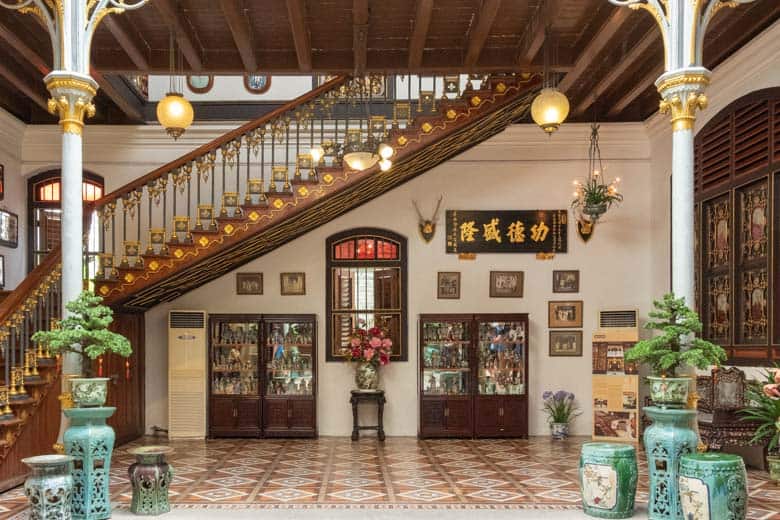





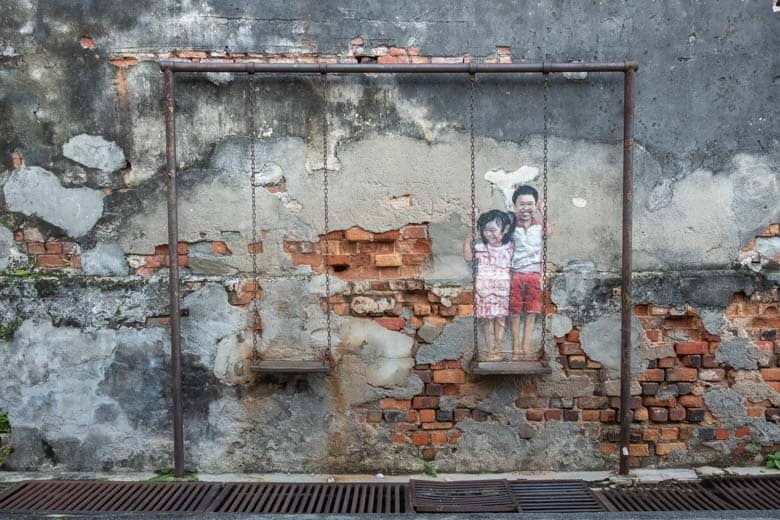


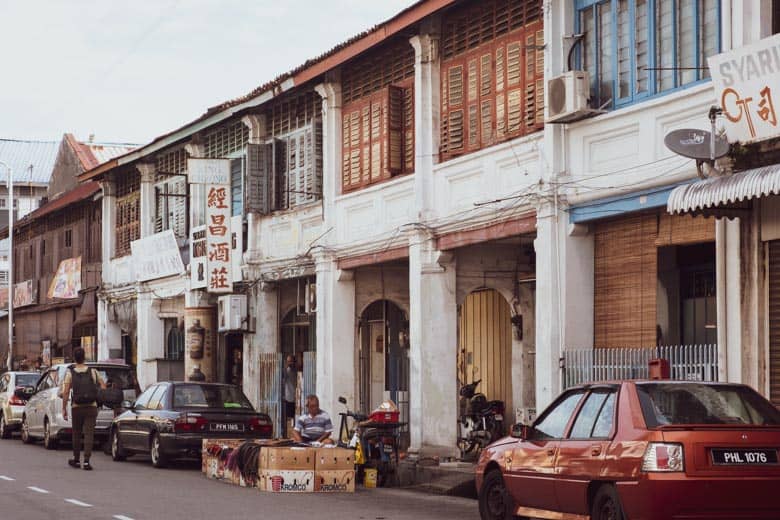
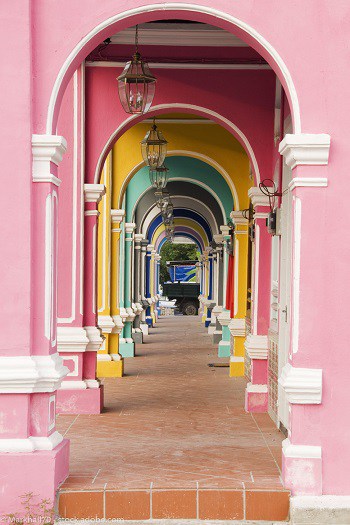


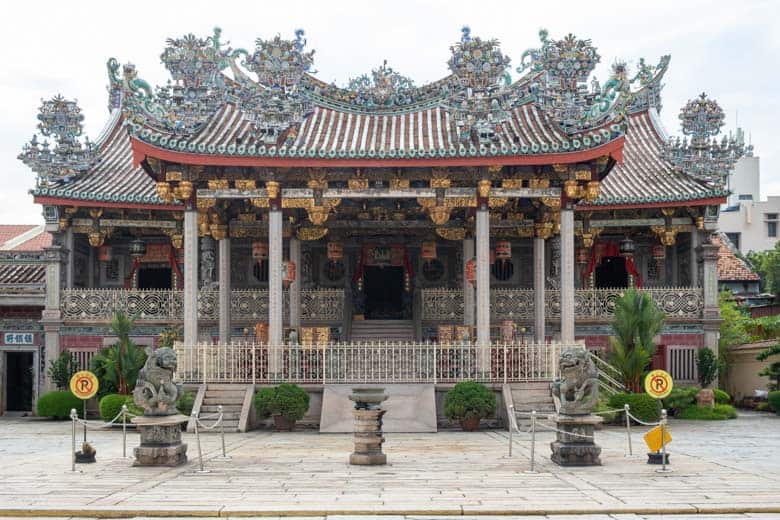

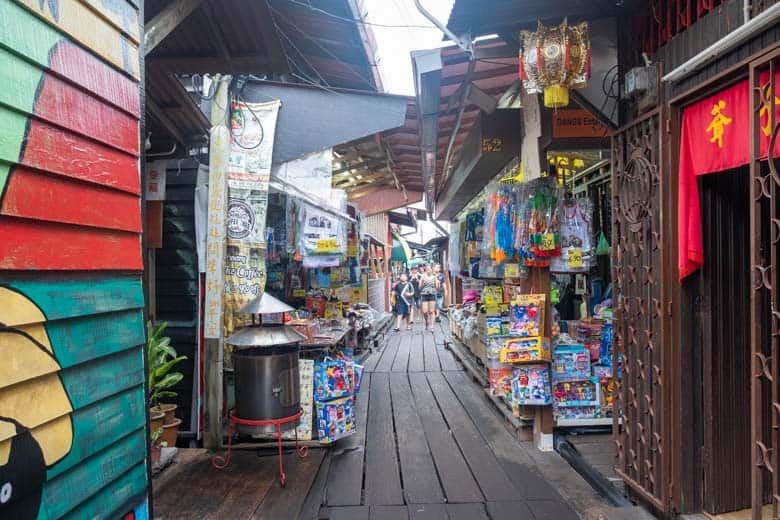


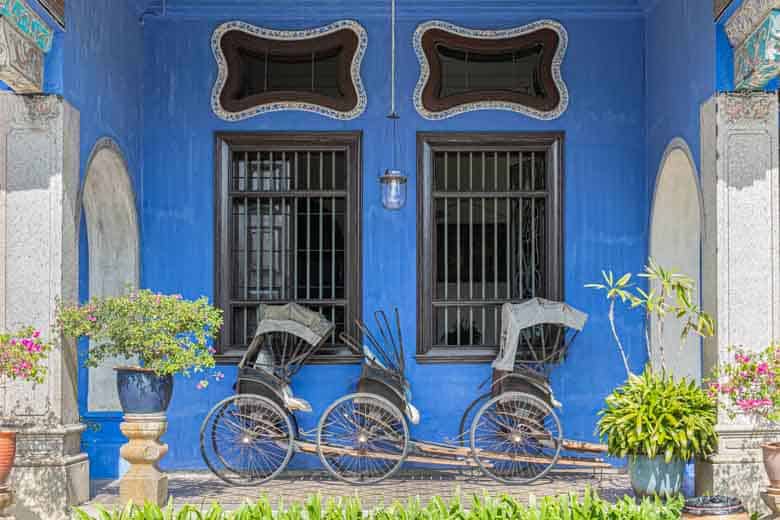


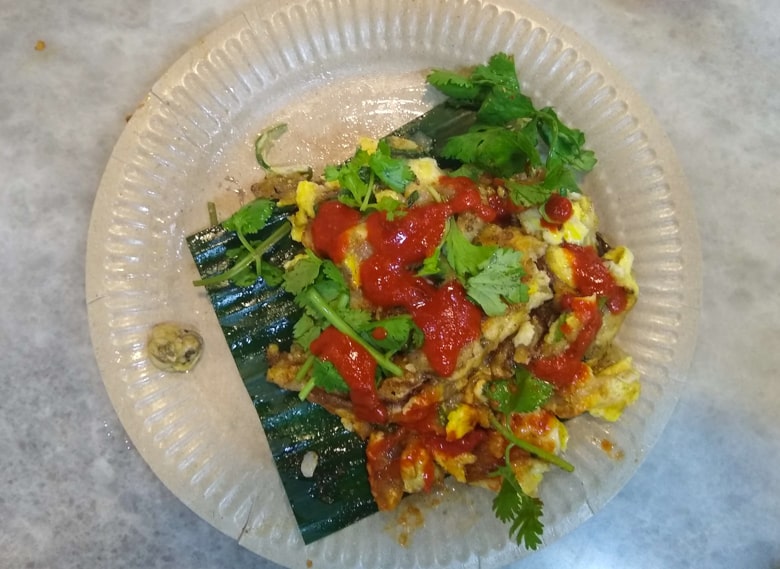
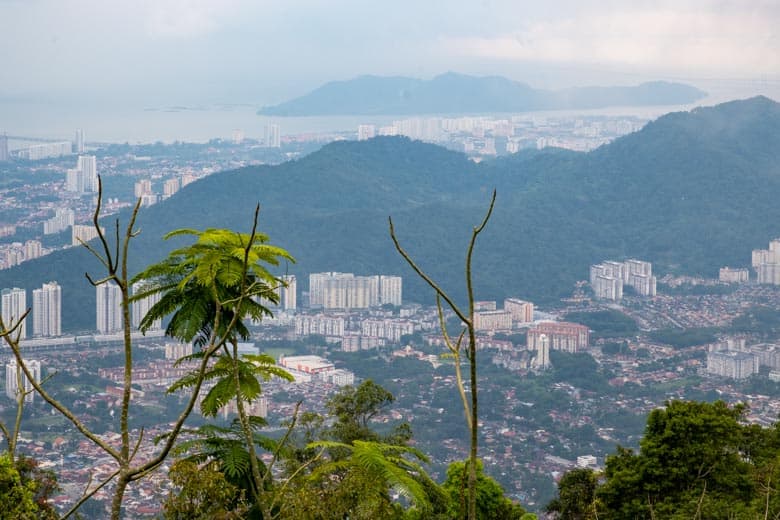




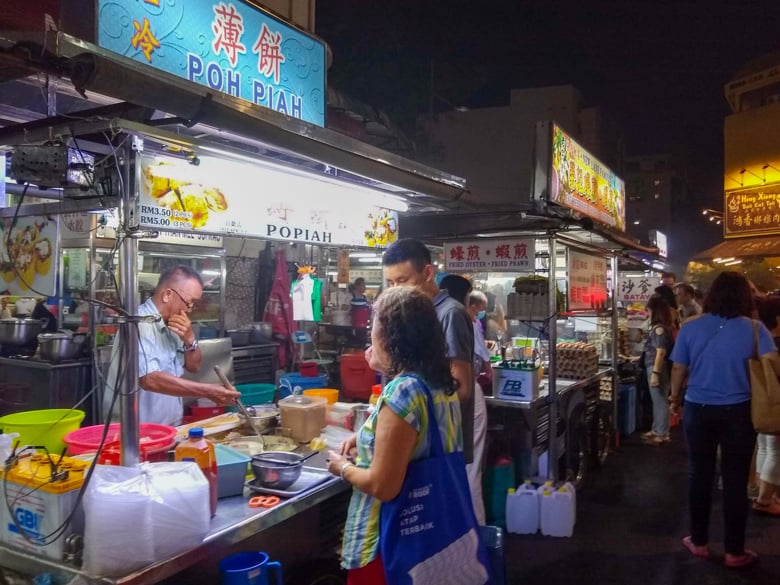






Wow! So much info! We did not get to Penang when we were in Malaysia but we certainly will next time. Saving for future reference. Thanks.
Thank you! I think Penang is the highlight of Malaysia. Hope you have a chance to visit soon!
We loved Penang too, especially all the street food! It was heaven for foodies like us and we really enjoyed the spice garden you mentioned – a really good introduction to Asian ingredients.
Yes, I also enjoyed the spice garden. I wish I had taken the cooking class. Did you just tour the garden or did you also take the class?
WOW this guide is an incredible resource – I think you got everything in there! Penang remains one of my all-time favorite places. Unfortunately the Blue Mansion was closed when I was there, so it’s a good reason to go back!
It’s too bad that you missed the Blue Mansion tour. It was the highlight of my stay in Penang. Was it closed for tours or for both tours and accommodations?
Such a great. Thanks for so much detail. Will be saving it for when we get to Malaysia. It would be a perfect quick break from Australia
Thank you! I hope you have a chance to visit soon!
While I’ve yet to visit this part of the world, I read every Penang article I see because the gorgeous photos of the street art always pulls me in. One of these days!
Dear friend superb guide you covered almost everything a traveler should look into. I’ve been thinking lately that I would love to visit
I am glad to read your blog about your travel experience very interesting thanks.
Your personal experiences and vivid descriptions truly bring the city to life, making me feel like I’m right there with you on this incredible journey. Your blog is a wonderful source of inspiration for fellow adventurers looking to explore the magic of.
Keep sharing your stories and insights – they’re a delight to read!
Sreenandhana from Kerala tourism.
Thank you!